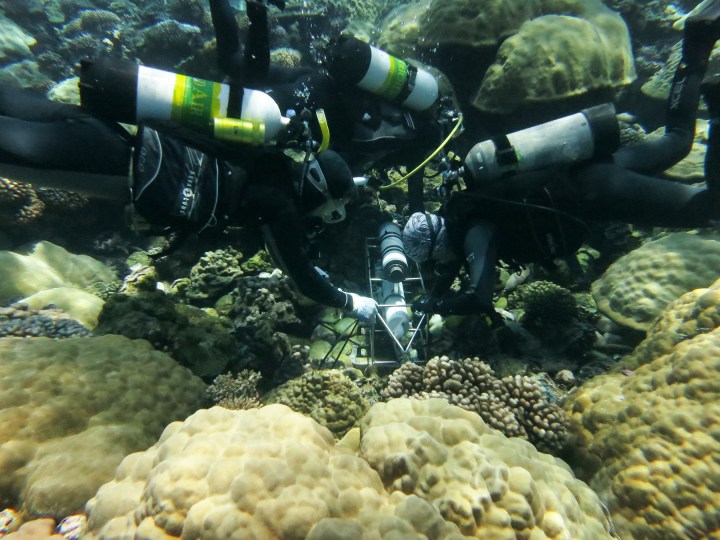In this post Adel Heenan and Kelvin Gorospe discuss their recent Practitioner’s Perspective article ‘Ecosystem monitoring for ecosystem-based management: using a polycentric approach to balance information trade-offs‘
Long-term ecosystem monitoring can be used to take the pulse of an ecosystem, much like a routine check-up with your doctor. Medical analogies like this are common in our field, as we work for the Pacific Reef Assessment and Monitoring Program (RAMP) to monitor coral reef ecosystems across the Pacific. We came across a very different beat-related metaphor to limn the message of our Practitioner’s Perspective – that of jazz-band ecosystem monitoring. We think it apt, as meeting the monitoring information needs for ecosystem-based management, seems like more an art, than a science.

With 20 years of progress towards operationalizing the ecosystem approach, significant challenges still remain in its application to the different facets of the management system, including long-term ecosystem monitoring. In this article we present our experience of Pacific RAMP, which over the last 15 years has flexed and adapted (modulated and transposed, to continue our music analogy) in response to the policy driven shift for information to support ecosystem-based management. This policy change increased the demand for more comprehensive, interdisciplinary monitoring data. However, given the resource constraints and management-scale within which we, as part of a national program, work – we have had to navigate multiple information trade-offs. This is because monitoring objectives differ across disciplines, sectors and management levels. For instance, information priorities vary by scale, i.e. priorities for a small-scale assessment such as a watershed or bay differ from those for a regional or national assessment, and among different biological assemblages – e.g. measuring the primary drivers affecting a reef’s fish populations differ from the drivers affecting benthic populations. What this has meant for us, as monitoring practitioners, is that we have had to balance the collection of data that is relevant at ecological scales, which are structured scientifically and driven by interacting biological, chemical and physical processes, with management and policy scales.

Striking that balance can be difficult, and we suggest that a polycentric view of monitoring is beneficial in understanding how the different elements of the monitoring system fit together. Polycentric monitoring is monitoring that is nested and blended across scales. We argue that polycentric monitoring is achievable via coordination, collaboration and compromise across disciplines and sectors, as well as geographic, ecological and governance scales. We emphasize that compromise between science and management is necessary, and that the first step in managing this compromise is to have an active and transparent evaluation of the trade-offs involved in collecting data at these different scales for different purposes.

In preparing the Practitioner Perspective we came across the jazz-band metaphor, used in the context of organization theory. Ohl et al. (2010) suggested a jazz-band model for socio-ecological research, which we find also applies to ecosystem monitoring. It perfectly depicts the ideal mindset of practitioners who must navigate trade-offs, create dynamic collaborations, and be agile enough to coordinate their activities in response to the growing policy demand for integration, all the while maintaining integrity in singular disciplines through time, as is necessary for a long-term monitoring effort. It’s quite possible that practitioners of integrated ecosystem monitoring could learn a thing or two from the organizational behaviour of a jazz band, where each musician (i.e. the monitoring actor whether it be a disciplinary expert or a program working at a specific scale of management) is bound by the musical score outlining the underlying chord structure (i.e. the vision for ecosystem, cross-scale monitoring), has the skill and is capable of taking on a solo (i.e. disciplinary experts are accountable and committed to produce high quality information), but also the wherewithal to provide support and appreciate the contribution of other team members.

We suggest starting with the tune Moanin’ by Charles Mingus. The listener will notice that throughout the piece, musicians rise to the soloist limelight, with the other players in turn adjusting their roles to create the chords, rhythms, and countermelodies in support of each soloist and the underlying beat of the jazz piece is never lost. This is not to say that monitoring is an improvisational art form. Rather, just as in jazz performance there is a dynamism between the individual and the nested system within which s/he sits that is neither set in stone nor entirely ad lib. A disciplinary specialist has the mastery to retain continuity and integrity within their field of expertise, but must also be willing to collaborate with and support specialists from other disciplines. A local monitoring program is most knowledgeable about the resources and ecosystems in their jurisdiction, but this knowledge will benefit from added complexity and value if it is contextualized with the knowledge of systems at larger scales. Similarly, each individual musician is a master of their own instrument, but each solo would be meaningless without the support of the group. And musicians who only play solos will miss out on collaborative opportunities that would otherwise provide richer context. To the untrained ear, sometimes their performance might sound like chaos, but they are in fact in communication, coordinated and organized, demonstrating that the collective whole is greater than the sum of its parts.
2 thoughts on “Jazz-band ecosystem monitoring”